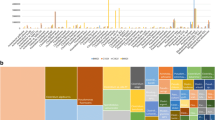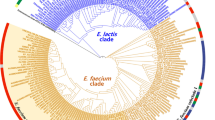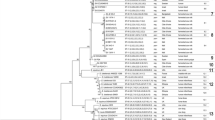Abstract
The Mannheimia subclades belong to the same bacterial genus but have taken divergent paths toward their distinct lifestyles. M. haemolytica + M. glucosida are potential pathogens of the respiratory tract in the mammalian suborder Ruminantia, whereas M. ruminalis, the supposed sister group, lives as a commensal in the ovine rumen. We have tested the hypothesis that horizontal gene transfer of the leukotoxin operon has catalyzed pathogenic adaptation and speciation of M. haemolytica + M. glucosida, or other major subclades, by using a strategy that combines compositional and phylogenetic methods. We show that it has been vertically inherited from the last common ancestor of the diverging Mannheimia subclades, although several strains belonging to M. ruminalis have lost the operon. Our analyses support that divergence within M. ruminalis following colonization of the ovine rumen was very rapid and that functional decay of most of the leukotoxin operons occurred early when the adaptation to the rumen was fastest, suggesting that antagonistic pleiotropy was the main contributor to losses in the radiating lineages of M. ruminalis. To sum up, the scenario derived from these analyses reflects two aspects. On one hand, it opposes the hypothesis of horizontal gene transfer as a catalyst of pathogenic adaptation and speciation. On the other hand, it indicates that losses of the leukotoxin operons in the radiating lineages of M. ruminalis have catalyzed their adaptation to a commensal environment and reproductive isolation (speciation).




Similar content being viewed by others
References
Akaike H (1973) Information theory as an extension of the maximum likelihood principle. In: Petrov BN, Csaksi F (eds) 2nd International Symposium on Information Theory. Akademiai Kiado, Budapest, pp 267–281
Myers EW, Lipman DJ (1990) Basic local alignment search tool. J Mol Biol 215:403–410
Ambagala TC, Ambagala AP, Srikumaran S (1999) The leukotoxin of Pasteurella haemolytica binds to β2 integrins on bovine leukocytes. FEMS Microbiol Lett 179:161–167
Andersson JO, Andersson SG (2001) Pseudogenes, junk DNA, and the dynamics of Rickettsia genomes. Mol Biol Evol 18:829–839
Angen Ø, Olsen JE, Bisgaard M (1997a) Further studies of the relationships among strains classified as taxon 15, taxon 18, taxon 20, [Pasteurella] granulomatis of the [Pasteurella] haemolytica-complex in ruminants using quantitative evaluation of phenotypic data. Zentralbl Bakteriol 286:317–332
Angen Ø, Aalbaek B, Falsen E, Olsen JE, Bisgaard M (1997b) Relationships among strains classified with the ruminant Pasteurella haemolytica-complex using quantitative evaluation of phenotypic data. Zentralbl Bakteriol 285:459–479
Angen Ø, Caugant DA, Olsen JE, Bisgaard M (1997c) Genotypic relationships among strains classified under the [Pasteurella] haemolytica-complex as indicated by ribotyping and multilocus enzyme electrophoresis. Zentralbl Bakteriol 286:333–354
Angen Ø, Mutters R, Caugant DA, Olsen JE, Bisgaard M (1999) Taxonomic relationships of the [Pasteurella] haemolytica complex as evaluated by DNA-DNA hybridizations and 16S rRNA sequencing with proposal of Mannheimia haemolytica gen. nov., comb. nov., Mannheimia granulomatis comb. nov., Mannheimia glucosida sp. nov., Mannheimia ruminalis sp. nov. and Mannheimia varigena sp. nov. Int J Syst Bacteriol 49:67–86
Blackall P, Angen Ø, Fegan N, Blackall L, Mutters R, Bisgaard M (2001) Characterisation of a novel Mannheimia sp from Australian feedlot cattle. Aust Vet J 79:634–639
Boucher Y, Douady CJ, Papke RT, Walsh DA, Boudreau MER, Nesbø CL, Case RJ, Doolittle WF (2003) Lateral gene transfer and the origins of prokaryotic groups. Annu Rev Genet 37:283–328
Burnham KP, Anderson DR (2002) Model selection and multi-model inference: a practical information-theoretic approach. Springer–Verlag, New York
Burrows LL, Olah-Winfield E, Lo RY (1993) Molecular analysis of the leukotoxin determinants from Pasteurella haemolytica serotypes 1 to 16. Infect Immun 61:5001–5007
Campbell A, Mrazek J, Karlin S (1999) Genome signature comparisons among prokaryote, plasmid, and mitochondrial DNA. Proc Natl Acad Sci USA 96:9184–9189
Chang YF, Renshaw HW, Martens RJ, Livingston CW Jr (1986) Pasteurella haemolytica leukotoxin: chemiluminescent responses of peripheral blood leukocytes from several different mammalian species to leukotoxin- and opsonin-treated living and killed Pasteurella haemolytica and Staphylococcus aureus. Am J Vet Res 47:67–74
Christensen H, Kuhnert P, Olsen JE, Bisgaard M (2004) Comparative phylogenies of the housekeeping genes atpD, infB and rpoB and the 16S rRNA gene within the Pasteurellaceae. Int J Syst Evol Microbiol 54:1601–1609
Cooper VS, Lenski RE (2000) The population genetics of ecological specialization in evolving Escherichia coli populations. Nature 407:736–739
Davies RL, Whittam TS, Selander RK (2001) Sequence diversity and molecular evolution of the leukotoxin (lktA) gene in bovine and ovine strains of Mannheimia (Pasteurella) haemolytica. J Bacteriol 183:1394–1404
Davies RL, Campbell S, Whittam TS (2002) Mosaic structure and molecular evolution of the leukotoxin operon (lktCABD) in Mannheimia (Pasteurella) haemolytica, Mannheimia glucosida, and Pasteurella trehalosi. J Bacteriol 184: 266–277
Deshpande MS, Ambagala TC, Ambagala AP, Kehrli ME Jr, Srikumaran S (2002) Bovine CD18 is necessary and sufficient to mediate Mannheimia (Pasteurella) haemolytica leukotoxin-induced cytolysis. Infect Immun 70:5058–5064
Felsenstein J (2003) Inferring phylogenies. Sinauer Associates, Sunderland, MA
Highlander SK, Chidambaram M, Engler MJ, Weinstock GM (1989) DNA sequence of the Pasteurella haemolytica leukotoxin gene cluster. DNA 8:15–28
Highlander SK, Engler MJ, Weinstock GM (1990) Secretion and expression of the Pasteurella haemolytica leukotoxin. J Bacteriol 172:2343–2350
Highlander SK, Fedorova ND, Dusek DM, Panciera R, Alvarez LE, Rinehart C (2000) Inactivation of Pasteurella (Mannheimia) haemolytica leukotoxin causes partial attenuation of virulence in a calf challenge model. Infect Immun 68:3916–3922
Hooper SD, Berg OG (2002) Detection of genes with atypical nucleotide sequence in microbial genomes. J Mol Evol 54:365–375
Huelsenbeck JP, Ronquist F (2001) MRBAYES: Bayesian inference of phylogenetic trees. Bioinformatics 17:754–755
Jackman TR, Larson A, de Queiroz K, Losos JB (1999) Phylogenetic relationships and tempo of early diversification in Anolis lizards. Syst Biol 48:254–285
Jeyaseelan S, Hsuan SL, Kannan MS, Walcheck B, Wang JF, Kehrli ME, Lally ET, Sieck GC, Maheswaran SK (2000) Lymphocyte function-associated antigen 1 is a receptor for Pasteurella haemolytica leukotoxin in bovine leukocytes. Infect Immun 68:72–79
Jeyaseelan S, Kannan MS, Hsuan SL, Singh AK, Walseth TF, Maheswaran SK (2001) Pasteurella (Mannheimia) haemolytica leukotoxin-induced cytolysis of bovine leukocytes: role of arachidonic acid and its regulation. Microb Pathog 30:59–69
Kaehler KL, Markham RJ, Muscoplat CC, Johnson DW (1980) Evidence of species specificity in the cytocidal effects of Pasteurella haemolytica. Infect Immun 30:615–616
Karlin S, Mrazek J, Campbell AM (1997) Compositional biases of bacterial genomes and evolutionary implications. J Bacteriol 179:3899–3913
Koonin EV, Makarova KS, Aravind L (2001) Horizontal gene transfer in prokaryotes: quantification and classification. Annu Rev Microbiol 55:709–742
Lally ET, Kieba IR, Sato A, Green CL, Rosenbloom J, Korostoff J, Wang JF, Shenker BJ, Ortlepp S, Robinson MK, Billings PC (1997) RTX toxins recognize a β2 integrin on the surface of human target cells. J Biol Chem 272:30463–30469
Lawrence JG (1997) Selfish operons and speciation by gene transfer. Trends Microbiol 5:355–359
Lawrence JG (1999) Gene transfer, speciation, and the evolution of bacterial genomes. Curr Opin Microbiol 2:519–523
Lawrence JG (2002) Gene transfer in bacteria: speciation without species? Theor Popul Biol 61:449–460
Lawrence JG, Ochman H (1997) Amelioration of bacterial genomes: rates of change and exchange. J Mol Evol 44:383–397
Lawrence JG, Roth JR (1996) Selfish operons: horizontal transfer may drive the evolution of gene clusters. Genetics 143:1843–1860
Lawrence JG, Roth JR (1999) Genomic flux: genome evolution by gene loss and acquisition. In: Charlebois RL (ed) Organization of the prokaryotic genome. ASM Press, Washington, DC, pp 263–289
Leite F, Sylte MJ, O’Brien S, Schultz R, Peek S, van Reeth K, Czuprynski CJ (2002) Effect of experimental infection of cattle with bovine herpesvirus-1 (BHV-1) on the ex vivo interaction of bovine leukocytes with Mannheimia (Pasteurella) haemolytica leukotoxin. Vet Immunol Immunopathol 84:97–110
Li J, Clinkenbeard KD, Ritchey JW (1999) Bovine CD18 identified as a species specific receptor for Pasteurella haemolytica leukotoxin. Vet Microbiol 67:91–97
Lo RY, Strathdee CA, Shewen PE (1987) Nucleotide sequence of the leukotoxin genes of Pasteurella haemolytica A1. Infect Immun 55:1987–1996
Mira A, Ochman H, Moran NA (2001) Deletional bias and the evolution of bacterial genomes. Trends Genet 17:589–596
Moran NA, Mira A (2001) The process of genome shrinkage in the obligate symbiont Buchnera aphidicola. Genome Biol 2:research0054
Morgenstern B (1999) DIALIGN 2: improvement of the segment-to-segment approach to multiple sequence alignment. Bioinformatics 15:211–218
Murphy GL, Whitworth LC, Clinkenbeard KD, Clinkenbeard PA (1995) Hemolytic activity of the Pasteurella haemolytica leukotoxin. Infect Immun 63:3209–3212
Nilsson AI, Koskiniemi S, Eriksson S, Kugelberg E, Hinton JC, Andersson DI (2005) Bacterial genome size reduction by experimental evolution. Proc Natl Acad Sci USA 102:12112–12116
Nylander JA (2004) MrModeltest, version 2.2. Uppsala University, Uppsala
Petras SF, Chidambaram M, Illyes EF, Froshauer S, Weinstock GM, Reese CP (1995) Antigenic and virulence properties of Pasteurella haemolytica leukotoxin mutants. Infect Immun 63:1033–1039
Posada D, Buckley TR (2004) Model selection and model averaging in phylogenetics: advantages of akaike information criterion and bayesian approaches over likelihood ratio tests. Syst Biol 53:793–808
Rambaut A, Drummond AJ (2004) Tracer, version 1.3. University of Oxford, Oxford
Ronquist F, Huelsenbeck JP (2003) MrBayes 3: Bayesian phylogenetic inference under mixed models. Bioinformatics 19:1572–1574
Schluter D (2000) The ecology of adaptive evolution. Oxford University Press, Oxford
Shewen PE, Wilkie BN (1982) Cytotoxin of Pasteurella haemolytica acting on bovine leukocytes. Infect Immun 35:91–94
Silva FJ, Latorre A, Moya A (2001) Genome size reduction through multiple events of gene disintegration in Buchnera APS. Trends Genet 17:615–618
Slowinski JB (2001) Molecular polytomies. Mol Phylogenet Evol 19:114–120
Strathdee CA, Lo RY (1989) Regulation of expression of the Pasteurella haemolytica leukotoxin determinant. J Bacteriol 171:5955–5962
Tatum FM, Briggs RE, Sreevatsan SS, Zehr ES, Hsuan SL, Whiteley LO, Ames TR, Maheswaran SK (1998) Construction of an isogenic leukotoxin deletion mutant of Pasteurella haemolytica serotype 1: characterization and virulence. Microb Pathog 24:37–46
Vulic M, Dionisio F, Taddei F, Radman M (1997) Molecular keys to speciation: DNA polymorphism and the control of genetic exchange in enterobacteria. Proc Natl Acad Sci USA 94:9763–9767
Vulic M, Lenski RE, Radman M (1999) Mutation, recombination, and incipient speciation of bacteria in the laboratory. Proc Natl Acad Sci USA 96:7348–7351
Welch RA (2001) RTX toxin structure and function: a story of numerous anomalies and few analogies in toxin biology. Curr Top Microbiol Immunol 257:85–111
Yang Z (1997) PAML: a program package for phylogenetic analysis by maximum likelihood. Comput Appl Biosci 13:555–556
Yang Z, Roberts D (1995) On the use of nucleic acid sequences to infer early branchings in the tree of life. Mol Biol Evol 12:451–458
Zhang J (1999) Performance of likelihood ratio tests of evolutionary hypotheses under inadequate substitution models. Mol Biol Evol 16:868–875
Acknowledgments
We thank Christel G. Buerholt and Tony Bønnelycke for technical assistance and Sean D. Hooper for enlightening discussions. This work was supported by Grant 9702797 from the Danish Agricultural and Veterinary Research Council.
Author information
Authors and Affiliations
Corresponding author
Additional information
[Reviewing Editor: Dr. David Guttman]
Jesper Larsen and Anders G. Pedersen contributed equally to this work.
Rights and permissions
About this article
Cite this article
Larsen, J., Pedersen, A.G., Christensen, H. et al. Evidence for Vertical Inheritance and Loss of the Leukotoxin Operon in Genus Mannheimia . J Mol Evol 64, 423–437 (2007). https://doi.org/10.1007/s00239-006-0065-3
Received:
Accepted:
Published:
Issue Date:
DOI: https://doi.org/10.1007/s00239-006-0065-3




